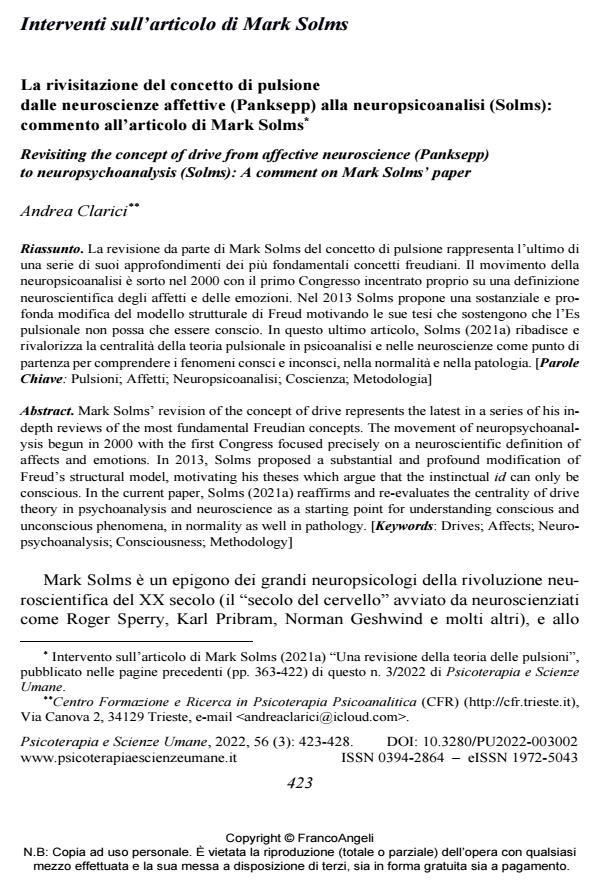Interventi sull’articolo di Mark Solms. La rivisitazione del concetto di pulsione dalle neuroscienze affettive (Panksepp) alla neuropsicoanalisi (Solms): commento all’articolo di Mark Solms
Titolo Rivista PSICOTERAPIA E SCIENZE UMANE
Autori/Curatori Andrea Clarici
Anno di pubblicazione 2022 Fascicolo 2022/3 Lingua Italiano
Numero pagine 6 P. 423-428 Dimensione file 34 KB
DOI 10.3280/PU2022-003002
Il DOI è il codice a barre della proprietà intellettuale: per saperne di più
clicca qui
Qui sotto puoi vedere in anteprima la prima pagina di questo articolo.
Se questo articolo ti interessa, lo puoi acquistare (e scaricare in formato pdf) seguendo le facili indicazioni per acquistare il download credit. Acquista Download Credits per scaricare questo Articolo in formato PDF

FrancoAngeli è membro della Publishers International Linking Association, Inc (PILA)associazione indipendente e non profit per facilitare (attraverso i servizi tecnologici implementati da CrossRef.org) l’accesso degli studiosi ai contenuti digitali nelle pubblicazioni professionali e scientifiche
La revisione da parte di Mark Solms del concetto di pulsione rappresenta l’ultimo di una serie di suoi approfondimenti dei più fondamentali concetti freudiani. Il movimento della neuropsicoanali-si è sorto nel 2000 con il primo Congresso incentrato proprio su una definizione neuroscientifica degli affetti e delle emozioni. Nel 2013 Solms propone una sostanziale e profonda modifica del modello strutturale di Freud motivando le sue tesi che sostengono che l’Es pulsionale non possa che essere conscio. In questo ultimo articolo, Solms (2021a) ribadisce e rivalorizza la centralità della teoria pulsionale in psicoanalisi e nelle neuroscienze come punto di partenza per comprende-re i fenomeni consci e inconsci, nella normalità e nella patologia.;
Keywords:Pulsioni; Affet-ti; Neuropsicoanalisi; Coscienza; Metodologia
- Clarici A. (2015). Neuropsychoanalysis has an influence on psychoanalytic technique but not on the psychoanalytic method. Neuropsychoanalysis, 17, 1: 39-51. DOI: 10.1080/15294145.2015.1034291
- Clarici A. (2019). To be or not to be a neuropsychoanalyst... that is the question! In: Balchin R., Barry V., Bazan A., Blechner M.J., Clarici A., Flores Mosri D., Fotopoulou A., Goergen M.S., Kessler R., Matthis I., Muñoz Zúñiga J.F., Northoff G., Olds D., Oppenheim L., Reismann-Lagrèze D., Tsakiris M., Watt D., Yeates G. & Zellner M., Reflections on 20 years of neuropsychoanalysis. Neuropsychoanalysis, 2019, 21: 2: 97-100. DOI: 10.1080/15294145.2019.1695978
- Freud S. (1899 [1900]). L’interpretazione dei sogni. Opere, 3. Torino: Boringhieri, 1966.
- Freud S. (1915). Metapsicologia. Pulsioni e loro destini. Opere, 8: 13-35. Torino: Boringhieri, 1976.
- Freud S. (1922 [1923]). L’Io e l’Es. Opere, 9: 471-520. Torino: Boringhieri, 1977.
- Friston K. (2009). The free-energy principle: A rough guide to the brain? Trends in Cognitive Sciences, 13, 7: 293-301.
- Friston K. (2010). The free-energy principle: A unified brain theory? Nature Reviews Neuroscience, 11, 2: 127-138.
- Panksepp J. (1998). Affective Neuroscience: The Foundations of Human and Animal Emotions. New York: Oxford University Press
- Panksepp J. & Biven L. (2012). The Archaeology of Mind: Neuroevolutionary Origins of Human Emotions. Foreword by Daniel J. Siegel. New York: Norton (trad. it.: Archeologia della mente: origini neuroevolutive delle emozioni umane. Prefazione di Daniel J. Siegel. Postfazione di Andrea Clarici. Edizione italiana a cura di Andrea Clarici e Antonio Alcaro. Milano: Raffaello Cortina, 2014).
- Quinodoz J.M. (2013). Reading Freud: A Chronological Exploration of Freud’s Writings. London: Routledge.
- Sacks O. (1984). A Leg to Stand On. New York: Simon and Schuster (trad. it.: Su una gamba sola. Milano: Adelphi, 1991).
- Solms M. (2013). The conscious id. Neuropsychoanalysis, 15, 1: 5-85.
- Solms M. (2018). La coscienza dell’Es: psicoanalisi e neuroscienze. Cura e prefazione di Andrea Clarici. Milano: Raffaello Cortina.
- Solms M. (2021a). Revision of drive theory. Journal of the American Psychoanalytic Association, 69, 6: 1033-1091.
- Solms M. (2021b). Response to the commentaries. Journal of Consciousness Studies, 28, 11: 222-248.
Andrea Clarici, Interventi sull’articolo di Mark Solms. La rivisitazione del concetto di pulsione dalle neuroscienze affettive (Panksepp) alla neuropsicoanalisi (Solms): commento all’articolo di Mark Solms in "PSICOTERAPIA E SCIENZE UMANE" 3/2022, pp 423-428, DOI: 10.3280/PU2022-003002